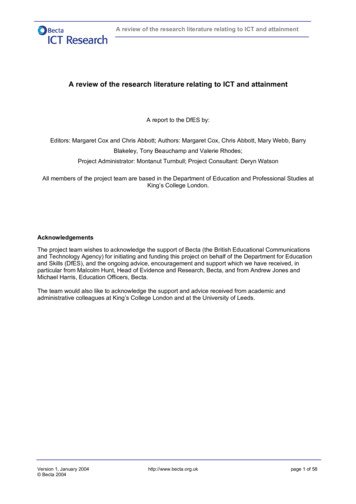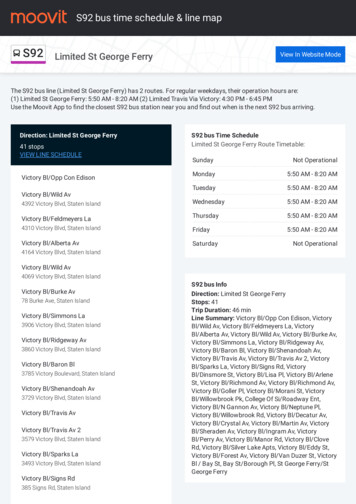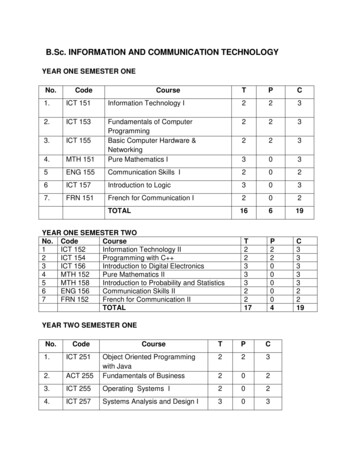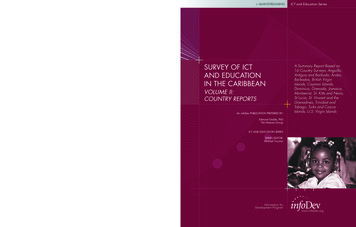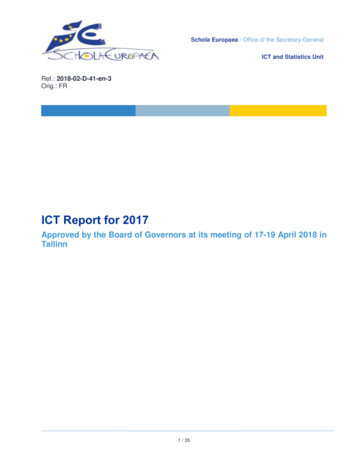
Transcription
Schola Europaea / Office of the Secretary-GeneralICT and Statistics UnitRef.: 2018-02-D-41-en-3Orig.: FRICT Report for 2017Approved by the Board of Governors at its meeting of 17-19 April 2018 inTallinn1 / 35
Schola Europaea / Office of the Secretary-GeneralICT and Statistics UnitContentsICT Report for 2017 .1Introduction.4Note of the Budgetary Committee .4The year 2017 .51.ICT Strategy: ICT Governance Group . 52.School Management System (SMS) administrative application . 5a.b.Management of school exchanges . 5School fees management . 63.Statistics Platform – Business Intelligence . 64.The Central Enrolment Authority (CEA) for Brussels application . 65.Staff Management application (PERSEE) . 66.Mission expenses management application . 67.Collaboration platform for administrative purposes . 7a.b.The OSGES’ administrative collaboration platform . 7The schools’ administrative collaboration platform . 98.SAP: HEC and interfaces with banks . 99.Active Identity Management in the Active Directory (MIM project) . 1010.a.b.Operational IT system and IT infrastructure (‘System and Networks’ Sub-Unit) . 11In general . 11From a more technical viewpoint . 1211.The ICT and Statistics Unit’s Service Desk . 1312.Microsoft Support Premier TIER 5 contract . 1413.Microsoft Office 365: TEAMS . 1714.IT purchases and contracts . 18From 2018 onwards .181.ICT Strategy: ICT Governance Group . 182.Master Data management . 203.School Management System (SMS) administrative application . 20a.b.4.New marking scale . 20Conformity with the GDPR . 21Statistics Platform – Business Intelligence . 212 / 352018-02-D-41-en-3
Schola Europaea / Office of the Secretary-GeneralICT and Statistics Unit5.Operational IT system and IT infrastructure (‘System and Networks’ Sub-Unit). 216.IT purchases and contracts . 23Situation of the OSGES’ ICT and Statistics unit .24‘Specialist’ profiles . 24Necessary strengthening of the ‘System and Networks’ Sub-Unit . 25Delegation of powers to the schools’ local IT teams . 26Distribution of ICT hardware in the schools on 31/12/2017 .27Development of budgets .33Proposal .353 / 352018-02-D-41-en-3
Schola Europaea / Office of the Secretary-GeneralICT and Statistics UnitIntroductionThe purpose of this document is to provide a detailed ICT report on the year 2017, namely to give a status report on the main objectives defined for the year 2017 in the previous ICT Report:missions accomplished, uncompleted and/or non-initiated missions; an overview of the significant events in the year 2017 as part of the information system (IS) ofthe European Schools and its IT resources.It also provides information about the current and future objectives.This document is aimed at a very wide readership: heads of delegations, IT specialists, schools’directors, bursars, colleagues, etc. Now IT is a very broad field, being a specialist area and highlytechnical. In addition, there is the complexity of the European Schools’ IT infrastructure, plus its systemof operation, which is unique. This document has therefore been written, as far as possible, inaccessible language, avoiding technical terms and explanations.This report has been produced solely by the OSGES’ ICT and Statistics Unit.In the context of the mandate given by the Board of Governors at its December 2015 meeting, thePedagogical Development Unit also took charge of the organisation and follow-up on the IT-PEDAWG, a subgroup of the IT Strategies WG, whose remit is to deal with all subjects with a pedagogicalpurpose in the context of new technologies. During the year 2017, that subgroup conducted a surveyamongst 2 808 teachers in the system. The results of that survey and certain recommendationsresulting therefrom are set out in the Report of the IT-PEDA Subgroup (ref.: 2018-01-D-22).Note of the Budgetary CommitteeThe Budgetary Committee took note of the report and invited the Board of Governors also to take noteof it.4 / 352018-02-D-41-en-3
Schola Europaea / Office of the Secretary-GeneralICT and Statistics UnitThe year 20171. ICT Strategy: ICT Governance GroupThe IT Strategy Group met on numerous occasions in 2017, consisting of: meetings of the ADM Subgroup (chaired by the Head of the ICT Unit) for the administrative,financial and security aspects;meetings of the PEDA Subgroup (chaired by the Head of the Pedagogical Development Unit)for all the pedagogical aspects;joint meetings with the two Subgroups together (chaired by the Secretary-General), also for thepedagogical aspects.A great deal of work was done to produce a proposed IT strategy for the European Schools for thecoming years to be submitted to the Board of Governors.In the pedagogical area, it was very important to collect information on the European Schools’ currentsituation and to ascertain the teachers’ current and future needs in the context of the use of IT tools.To that end, an online survey was conducted amongst all the system’s teachers; a visit to the Laeken European School (school piloting the use of O365 but also their BringYour Own Device project) was also made by the members of the IT Strategy Group (workshop).2. School ManagementapplicationSystem(SMS)administrativeAs was the case the previous year, only the changes to SMS required for it to be compliant with thenew regulations were made.a. Management of school exchangesSchool exchanges were not managed in SMS, which led to problems for the encoding of data,absences, marks, assignment of work, etc. In addition, in O365, students on a school exchange werenot included on mailing lists, O365 groups, Teams, etc. The statistics were erroneous and the chargesto be invoiced to the families concerned could not be administered properly. In order to remedy thoseproblems, we requested MySchool to implement a solution. It is now possible to define that a studentis on a school exchange for a precise period. The school of origin can invoice the charges to the family.During the school exchange period, the student will appear on the different lists, in the O365 groups,courses, etc., associated with the school in which the school exchange is taking place.5 / 352018-02-D-41-en-3
Schola Europaea / Office of the Secretary-GeneralICT and Statistics Unitb. School fees managementCalculation of the school fees payable by the parents of category III children was changed in order tocomply with the new rules applicable in the event of late arrival or of departure before the end of theschool year.3. Statistics Platform – Business IntelligenceThe BO platform was migrated to the new EU environment. Users connect with their EU login.As in previous years, training sessions on the reporting tool were organised at the OSGES. Thetraining sessions were intended for the staff of the European Schools and of the Central Office.New BO statistical reports for the schools’ Administrative Boards were produced. The purpose of thosereports is to harmonise and make more coherent and consistent the different reports used forpreparation of Administrative Board meetings.4. The Central Enrolment Authority (CEA) for BrusselsapplicationAs is the case every year, the application was updated to bring it into line with the enrolment policy’snew rules.5. Staff Management application (PERSEE)The application was migrated to the EU environment. Users thus log in with their EU access codes(enhanced security).The application was modified to allow application of the IT identity management policy in the EuropeanSchools.Functionalities for backup of actions carried out in PERSEE were also developed (Logs).Recurrent problems (problems with CIPAL (a Belgian inter-municipal ICT service provider for publicauthorities), incomplete file problem, etc.) had to be resolved.6. Mission expenses management applicationAn application enabling expenses to be reimbursed to staff of the European Schools who have beenaway on mission was developed. The application is in the testing phase at the OSGES. It willsubsequently be tested gradually by the schools and then rolled out.6 / 352018-02-D-41-en-3
Schola Europaea / Office of the Secretary-GeneralICT and Statistics UnitThis application has the advantage of complying with the rules in force – naturally – but also of keepinga record of all the data on a mission and the consent given by the chain of command and theauthorising officer.7. Collaboration platform for administrative purposesIn order to facilitate collaboration between the different members of the staff of the schools and of theOSGES, different SharePoint sites are being set up, their status being as follows:a. The OSGES’ administrative collaboration platformBaccalaureateTwo SharePoint sites have been created for their requirements.The first is a site available internally, on which all the Baccalaureate written examinations set andtaken in previous years, and model answers, can be found. Different reference data (metadata) are7 / 352018-02-D-41-en-3
Schola Europaea / Office of the Secretary-GeneralICT and Statistics Unitassociated with each document deposited. Those data subsequently enable filters to be created,making it easier to find the documents sought.The second is a secure site, which enables there to be collaboration with the OSGES, the schools,and the different people involved in setting the question papers for the Bac examinations.This secure site is composed of different libraries.The schools (ES and AES) deposit their proposals for questions by subject/language. Each schoolhas access solely to its own dedicated library and is not, therefore, able to access the other schools’libraries.Whenever the schools input the documents and associate with them all the attached metadatarequired, a workflow process is performed. This workflow process copies the documents in a workinglibrary. These libraries are divided up by subject/language. The work spaces are accessible solely tothe Inspectors/Experts associated with the subject.When the Bac questions are finalised, the documents are copied into the ‘Ready for Printing’ library,to be validated. That part still has to be developed.A link enables access to be gained to the public site from the secure site.Procurement NetworkThis site was the first SharePoint site rolled out. The site was designed and developed in conjunctionwith a Microsoft SharePoint expert.Tax Sub-UnitThis site is divided into different libraries. Public libraries which will the schools will be able to access.Internal libraries will serve as a work space for the Tax Sub-Unit.In order to be able to establish the differential adjustment, the Tax Sub-Unit needs specific documents.These documents, which will be managed on the schools’ SharePoint site and then via an approvalworkflow, will be available to the Tax Sub-Unit.When calculation of the adjustment has been completed, via a workflow approval, the documentcontaining the final calculation is sent to the school for acquiescence and then forwarded to the personwhom the calculation concerns.ICTAs for the Tax Sub-Unit site, this SharePoint site comprises public libraries which will be accessible tothe schools and work libraries which will be internal to the different sub-units forming part of the ICTUnit.8 / 352018-02-D-41-en-3
Schola Europaea / Office of the Secretary-GeneralICT and Statistics UnitThe procedures and guides will be found in the public libraries. These procedures and guides will bewritten in predefined templates. These templates include the different metadata associated with thelibraries. Before being published in the public libraries, the documents must be approved by differentpeople. This approval process is managed by a workflow. This site is under development.Security and SafetyThe person responsible for this sub-unit took direct charge of this site and it is under development.Internal Control CapabilityThis site is in the development phase.b. The schools’ administrative collaboration platformEach school will have a SharePoint site available to it for the administrative part and anotherSharePoint site for the administrative part.The site diagram for the administrative part will be common to all the schools. The site for thepedagogical part will be managed by the school itself.A first school (Varese) has agreed to pilot this project.As for the other SharePoint sites, some libraries are public, i.e. the schools can access them. Othersare secure and have limited access.All the documents used for Administrative Board meetings are made available to participants via thisSharePoint site.8. SAP: HEC and interfaces with banksSince May 2017, all the different payment applications used by the schools have been securelyconnected with the SAP ERP package: All payment files generated by SAP are automatically transferred to the school’s paymentsystem, with no possibility of their being intercepted, read and/or modified. All bank statement files are also transferred direct to the SAP server, with no possibility of theirbeing intercepted, read and/or modified.9 / 352018-02-D-41-en-3
Schola Europaea / Office of the Secretary-GeneralICT and Statistics UnitSchoolGo-live directpaymentLAEKENDECEMBER 14WOLUWEDECEMBER 14IxellesDECEMBER 14MOLAPRIL 15UCCLEDECEMBER 14Provider of thesolution.Isabel with ICS(Realdolmen)Isabel with ICS(Realdolmen)Isabel with ICS(Realdolmen)Isabel with ICS(Realdolmen)Isabel with ICS(Realdolmen)Servers’ siteOSGOSGOSGOSGOSGLUXEMBOURG SEPTEMBER 16MAMEROCTOBER 16ISAGATEISAGATELuxembourgMamerVareseAUGUST 16Software SincroOSGMUNICHMARCH 17COGONOSGFrankfurtMARCH 17COGONOSGKarlsruheAPRIL 17COGONOSGBERGENJUNE 17ABNAMRO BANKOSGALICANTEMAY 2017BBVA BANKOSG9. Active Identity Management in the Active Directory (MIMproject)FIM (Forefront Identity Management) has become MIM (Microsoft Identity Management).For the first time, MIM automatically managed the transition from one school year to the next. Thischangeover was a success and involved: Deleting the old 15-16 listsCreating the new 17-18 listsCreating the new users (teachers and students).The many mailing lists created and automatically updated on the basis of the data encoded in SMSand PERSEE were made secure in order to have perfect control over the people entitled to use themor otherwise.Use of external consultancy services had to be increased significantly for this project’s needs, formaintenance and support but also for the tool’s development.10 / 352018-02-D-41-en-3
Schola Europaea / Office of the Secretary-GeneralICT and Statistics Unit10.Operational IT system and IT infrastructure (‘Systemand Networks’ Sub-Unit)a. In generalIn 2017, the ‘System’ Sub-Unit was faced with the harsh reality of the market and the workload whichmanagement of the environment recently put in place demands.The ‘System’ Sub-Unit, which normally comprises three people, has not managed to reach its full staffcomplement for more than two years. Despite publication of the posts and downgrading of thetechnical expectations, the ICT Unit is unable to recruit high-quality and qualified multi-skilled ICT staff.Throughout the year, two people at best had to manage the entire system and network.The warning about the critical situation announced in 2016, relating that for the European Schools’proper operation, the services must now be available 24/7, was not heeded. The fact that the ‘System’Sub-Unit engineers frequently have to intervene outside working hours, including when they are onleave/abroad, did not change, with direct consequences for the team and the organisation.In July 2017, the network engineer decided to leave the organisation and it has not proved possiblefor him to be replaced to date. Yet it is not for lack of trying (Publication, Temporary Staff, LinkedIn,companies specialising in recruitment, etc.) and when a potential good candidate is found, he or sherefuses the offer as it is not deemed sufficiently attractive.Concretely, there is only one person left with a global vision of what has been put in place and who issufficiently multi-skilled to act at all levels as required. There is quite a high risk that this person willleave as there is no longer any means of retaining specialist resources within the European Schools.Consequently, in 2017, the ‘System’ Sub-Unit focused mainly on maintenance of the services alreadyin place and responded reactively to all the emergency situations with which it was faced.It was not possible for any significant advance to be made with respect to withdrawal of the old servershosting ADM EURSC.ORG, LEARNING GATEWAY, LG.ADM.ORG and DOCEE. The same findingapplies to introduction of the new EURSC.EU domain in the European Schools. This project isstruggling to become established and the schools are making their impatience felt with the CentralOffice, which cannot manage to meet demand.No progress could be made with the second Data Centre to accommodate the extension of servicesalready in place in the first Data Centre. However, two Disaster Recovery Plans were devised andtested. The first involved the Exchange 2013 environment, a messaging system for the administrativenetwork, which went very well. The second is Active Directory Scholae for the pedagogical network,which was unsuccessful. Shortage of time and resources meant that a second attempt could not beorganised.Thanks to Microsoft consultancy, a test environment was created for the European Schools’ websitewww.eursc.eu.No project connected with the network was followed up.In 2017, several of the European Schools’ website were victims of a ransom ware attack (malicioussoftware taking data hostage), which encrypted EURSC.ORG file servers that had not yet migrated toEURSC.EU. The impact on resources (human and material) was fairly significant and it took severaldays for the situation to be restored to normal.As presented in 2016, the projects and tasks managed by the ‘System’ Sub-Unit is fairly impressive(see below ‘From a more technical viewpoint’).With the current resources, the ‘System’ Sub-Unit can just about manage to respond to emergencies.In fact, broadly speaking, it is still unable to:11 / 352018-02-D-41-en-3
Schola Europaea / Office of the Secretary-GeneralICT and Statistics Unit Create documentationTransfer/exchange knowledgeProactively monitor the services (and detect intrusions, attacks, etc.)Respond within an appropriate time periodMove forward with the migration processHandle backup and restorationCarry out tests in the development environmentTest the Disaster Recovery PlanAttend training sessionsCommunicate with the schoolsb. From a more technical viewpointThe ICT infrastructure includes computer (fixed and wireless) and telephony networks (universal wiringand optical fibre links), mobile telephony, network operation services (DNS, DHCP, NTP, IP routing,etc.), the servers, the data storage system (including backups), virtualisation, access managementaspects, operational security, the computer hardware, the installed software base and basic ICTservices.The EURSC.EU domain, based on Active Directory (Windows Server 2012 R2), successfully passedRAP (Risk and Health Assessment Program) testing. RAP is a method of evaluation of the remoteenvironment. The data collected are encrypted then transmitted to Microsoft’s RAP servers in order tobe analysed and safely stored. This allows the results of the analysis to be consulted securely onlinethrough the Microsoft portal and at any time.A certified Microsoft engineer analysed the results and made recommendations and provided aknowledge transfer. The remedial plan did not reveal any critical deficiency. The Active Directory iskept up-to-date and meets the common requirements of the European Schools and Microsoft so thatit can receive adequate support if needed. This remains one of the European Schools’ imperatives.A SQL RAP was also carried out and the results were fairly positive.Otherwise, the situation is somewhat similar to 2016.Migration to Exchange 2013 was completed but the old EURSC.ORG server is still active andnecessary as two applications (Learning Gateway and DOCEE) do not allow the old environment tobe shut down permanently.The SQL 2012 servers were not extended to the second Data Centre because they have to becompletely upgraded and migrated to SQL 2016. The member of staff who was in charge of this jobunfortunately left the Central Office and it was not possible for a replacement to be found.The new operating system Windows 10 with End Point Protection (Antivirus) is being deployed at theCentral Office and in two schools (Woluwé and Luxembourg) via the Configuration Manager server.In each European School, the ‘System’ Sub-Unit is experiencing difficulty in progressing on the newdomain’s extension project because of lack of resources. Consequently, the DPs (Distribution Points)that were supposed to ensure harmonisation of the ICT hardware could only be deployed on two sites.The DFS (Data Files Servers), which are ready to accommodate the new file structure, have not beenused yet, again because of lack of resources. They would have been capable of avoiding the ransomware attack.12 / 352018-02-D-41-en-3
Schola Europaea / Office of the Secretary-GeneralICT and Statistics UnitThe identity management platform was updated from FIM (end of life) to MIM. This tool allows thereto be provisioning of the entire Active Directory SCHOLAE.EU, which covers all the students andteachers.The Business Objects platform was migrated from EURSC.ORG to EURSC.EU, which is more secure.It provides greater security and it is now mandatory to use European login credentials (6 2@eursc.eu).The new servers are more robust and can handle a larger workload. In addition, the new versioncorrected several bugs in the previous versions. All the current BO reports can be used with the newservers.The Extranet was redeployed in order to offer end users a web platform to register for training sessionsorganised by the Central Office, using their EURSC.EU access codes.The second OMS (Operations Management Suite) monitoring platform which was deployed on theCloud in conjunction with SCOM On-Premises (System Center Operations Management) was notfollowed up. Yet OMS is a very [.] IT management solution based on the Microsoft Cloud that allowsthe On-Premises and Cloud Structure infrastructure to be managed and protected. OMS and SCOMwork together to offer a complete hybrid management experience. But lack of resources does not allowthese tools to be used proactively, i.e. to avoid and detect system failures or cyber-attacks.It was not possible for the security and communication platform to be strengthened. The objective wasto move the VPN tunnels from Policy-Based to Route-Based. No hardware or software was upgraded.Preparation of the changeover from IPv4 to IPv6 did not evolve. It was not possible for migration fromOSPF to OSPF v3 to take place either. As explained, at network level, there was no follow-up on anyproject.11.The ICT and Statistics Unit’s Service DeskThe ICT Service Desk fielded a very large number of requests throughout the year 2017. Almost 9000tickets were sent by the schools’ IT specialists, the members of the staff of the OSGES, the Inspectorsand the Heads of delegation:13 / 352018-02-D-41-en-3
Schola Europaea / Office of the Secretary-GeneralICT and Statistics UnitIn addition to this incident and query management, the Service Desk is charged with implementationand deployment of the new ticketing system (SCSM) in all the schools, the aim being to improvecollaboration with the schools’ IT specialists and their OSGES colleagues.They were actively involved in migration of all the OSGES’ computers to the new EURSC.EU domain(under Windows 10).They also handle all the logistics required for the running of the ICT training sessions provided at theOSGES, the number of which is increasing all the time.12.Microsoft Support Premier TIER 5 contractUnder this contract, support from Microsoft can be obtained in the event of incidents, something whichis essential, but at the same time it is possible to benefit from services allowing the IT infrastructure tobe maintained in accordance with good practice.14 / 352018-02-D-41-en-3
Schola Europaea / Office of the Secretary-GeneralICT and Statistics UnitStrengths and weaknesses of the European Schools according to MicrosoftConsumption of Microsoft Support Premier TIER 5 contract15 / 352018-02-D-41-en-3
Schola Europaea / Office of the Secretary-GeneralICT and Statistics UnitEURSC - Service Delivery Plan 2017IdentityData Storage -2017FebAprAD RAP(1113/04)Q2-2017MayJunJulQ3-2017AugAD RESRemed.(7-8/08)SQL RAP(8-10/08)DSE Sharepoint - Peter Loete - 41 daysAD RES(1923/06)EX RES(10-14/07)SepOctQ4-2017NovDecManaged 2018-02-D-41-en-316 / 35MarAD RESPrep(25/04)SCSM Remote Assistance - 8 days(3/04-23/06)Hy-V MigrPrep(13/12)Consumption - MICROSOFT Support Premier contract – planning for 2017
Schola Europaea / Office of the Secretary-GeneralICT and Statistics Unit13.Microsoft Office 365: TEAMSIn September 2017, the Microsoft TEAMS application was deployed in the European Schools. It is aspecific communication and collaboration platform for each course taught by teachers. By default,teachers are defined as being the ‘owners’ of the TEAMS platforms associated with each of theircourses and the students taking these courses are ‘members’ of them.Automatically and every night, depending on the data entered in the School Management System(SMS), the TEAMS platforms are created and the owners are added and/or deleted, as are themembers.The external consultancy was very much in demand when this project was run, in order to meet theteachers’ and students’ needs.17 / 352018-02-D-41-en-3
Schola Europaea / Office of the Secretary-GeneralICT and Statistics Unit14.IT purchases and contractsThe framework contracts offered by the European Commission (mainly DIGIT) are used as far aspossible. In 2017, the framework contracts which were renewed or which started were: SAPNATACHA III Lot 1 Acquisition channel for networking, telecom and videoconferencingequipment, as well as the provision of relevant maintenance and other associated servicesNATACHA III Lot 2 Complex or other than complex hardwareMTS III Mobile Telephony Communications services// Proximus Lot 1 Mobile TelephonyCommunications servicesMTS III Mobile Telephony Communications services// Proximus Lot 2 SMS Gatewayinfrastructure and servicesTRAINUSER III ICT Training for End UsersOAPM Lot 1 ONEPOINT SA - Provision of training sessions and workshops for IT staff inthe domains of MOC sessions (Microsoft Technical Courses)OAPM Lot 2 CAPGEMINI Educational Services BVFrom 2018 onwards1. ICT Strategy: ICT Governance GroupThe European Schools’ IT Strategy is coming into being at both the pedagogical and the administrativelevel.The very good collaboration between the
ICT Strategy: ICT Governance Group The IT Strategy Group met on numerous occasions in 2017, consisting of: meetings of the ADM Subgroup (chaired by the Head of the ICT Unit) for the administrative, . OSGES, different SharePoint sites are being set up, their status being as follows: a. The OSGES' administrative collaboration platform
